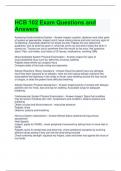HCB 102 Exam Questions and
Answers
Assessing Gastrointestinal System - Answer-Inspect: position, abdomen and other parts
of system as appropriate. Inspect vomit, feces noting volume and color and any signs of
GI bleeding. Auscultate abdomen for bowel sounds. Palpate the four abdominal
quadrants. look at what has gone in, what has come out and what it looks like when it
comes out. Trauma can occur anywhere from the mouth to the anus. Ask questions
about: Pain, oral intake, any history of GI issues, medications, vomiting, BMs
Musculoskeletal System Physical Examination - Answer-inspect for signs of
musculoskeletal injury such as: deformity, bruising, swelling
Palpate areas where you suspect injury
Compare sides of the body noting any assymetry
Allergic Reactions History Questions - Answer-Does the patient have any allergies,
have they been exposed to an allergen, what are their typical allergic reactions like,
does patient feel tightness in the chest or throat, have swelling around the face mouth
or tongue, or does the patient have difficulty breathing
Allergic Reaction Physical Assessment - Answer-Inspect points of contact with allergen,
patient's skin for hives, face and lips for swelling. Auscultate lungs for adequate
breathing,
Cardiovascular System Physical Examination - Answer-Inspect: Signs that condition
may be severe including skin color, temperature and condition; observe posture and
breathing
Obtain a pulse and blood pressure - note pulse pressure
Palpate: chest
Observe: posture and breathing
Nervous System Assessment - Answer-Mental Status obtained during primary
assessment
Note Speech
Inspect: pupils for PERRL, check peripheral movement by asking them to move feet or
hands
Palpate: spine for tenderness and deformity, check peripheral sensation by touching
different areas seeing if they can feel the area being touched
Check extremity strength- squeeze my fingers, raise and lower foot against the force of
my hands
, Unresponsive medical patient secondary assessment - Answer-You need to do a rapid
assessment of the entire body, Neck: jugular vein distention
Chest: presence and equality of breath sounds
Abdomen: distention, firmness, or rigidity .
Pelvis: incontinence of urine or feces
Extremities: Pulse, motor function, sensation, oxygen saturation, and medical
identification bracelets
Obtain and make record of baseline vitals
Bacteria - Answer-single cell organism that multiplies rapidly
virus - Answer-DNA or RNA is encased in a protein coating. Viruses cannot reproduce
outside of a living host cell
protozoa - Answer-unicellular microorganism that can infect the blood, brain, intestines
and other body
fungi - Answer-Tiny, primitive organisms that contain no chlorophyll
Helminthes - Answer-parasitic worm or fluke
Resivoir - Answer-a place where the pathogen grows and may or may not multiply
infectious agent (pathogen) - Answer-disease causing microorganism
Portal of exit - Answer-an exit route pathogens leave its host
mode of transmission - Answer-The manner in which an infectious agent moves from
one source to another
Primary Assessment - Answer-portion of the patient assessment where your primary
focus is life threats interfering with ABC
Rapid Trauma Assessment (RTA) - Answer-assessment that rapidly assesses head,
chest, abdomen, pelvis, extremities and posterior of the body to detect signs and
symptoms of injury
Secondary Assessment - Answer-done after the scene safety and primary assessment
that includes patient history, review of symptoms, physical examination and vital signs
reassessment - Answer-procedure of detecting changes in a patient's condition 4 step
process: repeat primary assessment, repeat recording vitals, repeat physical exam,
checking interventions
DCAP BTLS - Answer-deformities, contusions, abrasions, punctures/penetrations,
burns, tenderness, lacerations, swelling




